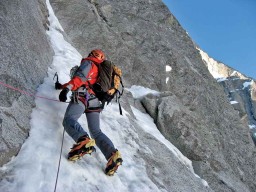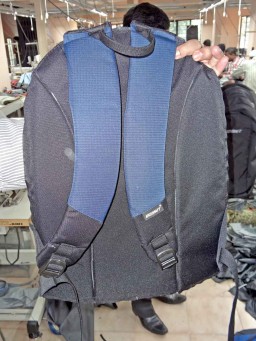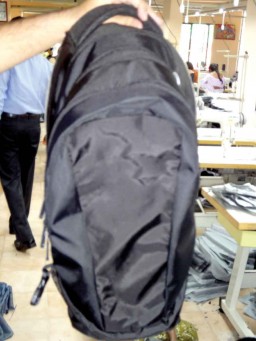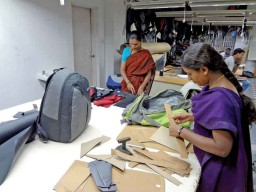 Backpacks, which began as an accessory for high school students in the 1980s, has evolved to a US $ 2 billion business with double-digit growth, since 58% of consumers own backpacks with fast changing fashion cycle for the same. The simple, US $ 15 packs with two zippered pockets are a thing of the past. Backpacks now are high tech and high fashion products. Some North Face backpacks now cost more than US $ 100. Tumi last year offered a US $ 695 limited edition with a solar panel to charge iPods and cell phones. In spite of huge market potential, there are only a handful of backpack manufacturers in the country. The most prominent of them is Wildcraft, a home grown brand with its products available across India at 70+ exclusive stores in over 30 cities, along with 250+ shop-in-shops and at 1000+ multi-branded stores across 100 cities today. In an attempt to witness first-hand the working of this product segment, Team StitchWorld met Siddharth Sood, Director and Gifi Gopalkrishnan, Head of Manufacturing, Wildcraft, to understand the company’s thought process of a utilitarian product and its manufacturing capabilities.
Backpacks, which began as an accessory for high school students in the 1980s, has evolved to a US $ 2 billion business with double-digit growth, since 58% of consumers own backpacks with fast changing fashion cycle for the same. The simple, US $ 15 packs with two zippered pockets are a thing of the past. Backpacks now are high tech and high fashion products. Some North Face backpacks now cost more than US $ 100. Tumi last year offered a US $ 695 limited edition with a solar panel to charge iPods and cell phones. In spite of huge market potential, there are only a handful of backpack manufacturers in the country. The most prominent of them is Wildcraft, a home grown brand with its products available across India at 70+ exclusive stores in over 30 cities, along with 250+ shop-in-shops and at 1000+ multi-branded stores across 100 cities today. In an attempt to witness first-hand the working of this product segment, Team StitchWorld met Siddharth Sood, Director and Gifi Gopalkrishnan, Head of Manufacturing, Wildcraft, to understand the company’s thought process of a utilitarian product and its manufacturing capabilities.

A Bangalore-based company Wildcraft was founded by Dinesh KS and couple of his friends, all passionate mountaineers and rock climbers in 1998. Started from a garage, Wildcraft today has come a long way to offer diversified product repertoire, which caters to clothing, equipment and footwear needs for the unexplored outdoors. With a compounded annual growth of 82 per cent from 2007 to 2012, Wildcraft crossed the Rs. 100 crore turnover milestone last year. Now, growing at a rate of 65 per cent, Wildcraft plans to sell 10 lakh pieces within 2013, aiming to be a Rs. 500 crore company by 2015. “When we started, it was more like a hobby and till 2007 it grew in the same way. During this period Wildcraft was associated with outdoor servicing. We had a team of trainers who organized outbound trainings… we used to dabble in everything from goods to services,” states Siddharth, a qualified MBA, who is associated with the company since 2001, and in 2007 joined full-time after quitting his job in the US.
It was in 2004 that Wildcraft decided to focus on products like backpacks and other adventure gear, and due to the absence of good manufacturers who would deliver the desired quality levels, the company started its own manufacturing facility in Bangalore. “If I wanted to get a jacket made I could go to 500 factories in and around India, but it was and still is difficult in case of backpacks. Manufacturing for us was therefore the need,” averred Siddharth. Back in 2007, when Siddharth joined the company, they had only 25 sewing machines and presently it has expanded to 900 sewing machines, distributed in 3 manufacturing facilities, two in Uttarahalli, Bangalore and one in Uttaranchal. The company has recently opened one more backpack manufacturing facility near the Peenya Industrial Area, in Bangalore. “Our factories specialize in manufacturing backpacks; and neither do we manufacture for someone else nor have plans to do the same in the future. We wish to make Wildcraft to a brand providing top notch outdoor gear and equipment to adventurers.” asserted Siddharth.
[bleft]“Our core customer has always been the adventure guy, and every 10 grams you add to his backpack, is dead weight for him. So everything has to have a purpose, which makes us a utility based brand.” [/bleft]
Though, the three units of Wildcraft produce 5,000 units of backpacks per day in varying styles, Siddharth believes the company is still quite basic in its processes and operations. “We are learning as we go along and we are taking inspiration from the practices of the apparel industry because the overall processes are the same. But if you talk in terms of industrial engineering, line balancing, setting batch sizes and things like that we are lacking, as they are quite subjective and one cannot copy the same from the apparel industry, as it has to be inculcated, invented and re-learned,” shares Siddharth.
Interestingly, 10% out of 1,500 sewing operators work on piece rate to handle one time orders and special corporate orders in small quantities, so as not to disturb the main sewing lines. “To handle 60 styles per month with quantities ranging from 500 to 800 pieces, we hire sewing operators with experience of working in local apparel factories, who are then re-trained for sewing backpacks by our experienced supervisors specialising in the same.

Of greater criticality is the product development, since it is to do with the functionalities of weight, weather and reliability The founder of the company, who is also India’s leading mountaineer, is himself the critical link between the people and their needs. Dinesh’s experience keeps the design team updated on the global trends and the new innovations that are required in the products. The design team has also done treks with Dinesh, so they themselves understand the utility of the products, they are designing.
Wildcraft has many designers from reputed institutes and a sampling section with a staff of 30, working together till the prototyping stage. “Since we are our own buyer, so the challenge is not to create numerous styles, but to judge the longevity of a design and do multiple runs of the same,” explained Siddharth, keeping in focus the four key elements: functionality, light weight, weather resilience and reliability.
Material weight or fibre thickness is an important consideration in the materials utilized for backpack construction. It is obvious that the higher the denier in a particular material, the higher the strength of the fabric, and the higher the weight as well. In fact, most of the higher quality backpacks use the denier value of the material as a selling point. Tenacity of the fabric is another factor that is kept in mind while choosing fabric for a backpack, as it defines a fabric’s ability to resist additional tearing, once a tear has started. Nylon type 6 or 66, are the most suitable fabrics which are used extensively because of their high tenacity or strength. Type 6 Nylon has low tenacity of 3.0 to 6.0 grams per denier; Type 66 Nylon is much stronger with a tenacity of 6.0 to 9.5 grams per denier.
[bleft]“Since the variation from backpack to backpack is too much, the sewing machines have been chosen keeping in mind the flexibility of the machine and the operator.” [/bleft]
Although polyester is also used for backpacks because of its waterproofing quality and high resistance to ultra-violet degradation, it loses in strength and light weightiness to Nylon or Rip-Stop Nylon, which is today the most commonly used material for upmarket backpack manufacturing. Rip-Stop Nylon has replaced the standard Nylon in the market and it is easy to distinguish Rip-Stop Nylon from standard Nylon by its regular grid pattern of heavy threads sewn in the warp and weft of the fabric at regular close intervals. Nylon when torn has a tendency to continue ripping under the slightest pressure, or can start unravelling; however, the rip-stop design, with heavier thread, usually nylon, can provide extra protection to help ensure that a pack will not tear easily or open up suddenly with a single tear.

Majority of backpack manufacturers use plastic “coil” zippers on their backpacks. The main advantage of the coil zipper is that if fabric gets caught in the teeth, the fabric can be gently pulled out without tearing. This is certainly a consideration since a backpack will often be crammed with clothing, a sleeping bag, or nylon bevy bags. Waterproof zippers are also available but they are rarely used because they are extremely expensive.
Since backpack’s primary motive is utilitarian, comfort and ergonomics are the two crucial factors to take care of during its design and construction. This can only be achieved by establishing a balance between materials, accessories and style of the backpack. An external pocket on the backpack may be of help to the user in staying organized, but would also add weight to the backpack and increase complexity in the sewing. “Our core customer has always been the adventure guy, and he is climbing the Himalayas or the Everest and every 10 grams you add to his backpack, is dead weight for him. So everything has to have a purpose, which makes us a utility based brand not a regular fashion brand,” averred Siddharth.
The basic framework of the backpack involves a front panel (mostly with an attached zipped compartment), a back panel (with or without laptop sleeve) and shoulder straps (stitched with the back panel).
A sweaty back is an unavoidable consequence of carrying a load, but a good back panel can mitigate the soggy-back syndrome. Either firm compression-moulded foam with grooves built in to permit a cooling airflow or swatches of soft, reticulated foam (it looks highly perforated) are used for dispersing sweat. Soft foam on shoulder straps is avoided since it allows puckers which than in turn induces abrasion with the skin. Operators are required to have mastered the art of bending, curving and covering foam without any crease marks. Ergonomically, an even weight distribution is most critical in a backpack. Any pack could be made reasonably comfortable if we could put a large percentage of its weight on the hips. The bones of the pelvis can bear a far heavier load than relatively wimpy shoulders. The obvious solution is to add a hip belt.
Manufacturing is not a challenge

At the Wildcraft factory, the manufacturing facility is no different from any apparel manufacturing facility and one would not find any systems specialized for backpack manufacturing except a few sewing machines. The cutting and spreading is completely manual with end cutters and straight knives being used for cutting. However, the scope for automated cutting is there because some of the panels like the back area padding are present in every back pack manufactured by the facility, while the small parts keeps changing in construction and can be handled manually. After the cutting, one of the most critical areas is bundling of backpack panels, which are to be fed to the sewing lines. The bundles are prepared for three areas – front, centre joint and back, which would be assembled after individual parts have been prepared. Since the smaller parts have similar appearance, a complete backpack is kept for the reference of the operators preparing the bundles with parts numbered accordingly so that they can easily count and ensure that all the parts have been bundled. This exercise is done for all the parts and also ensures that no panel is wrongly placed in bundles. Guidelines are also marked in the bundling stages for the sewing operators to follow, for operations like attaching a pouch on the front of the bag.
The sewing lines are majorly equipped with single heavy duty needles to guarantee greater seam strength and quality. Since the variation from backpack to backpack is too much, the machines for most of the sewing operations have been chosen keeping in mind the flexibility of the machine and the operator. Post-bed machines are used for tape attaching operation on all the seams. Till a couple of years ago, the company was working with basic lockstitch machines only, but has now installed automated machines with cylinder bed and flatbed with attachments and work aids to improve quality and productivity. “Cylinder-bed sewing machines are of utmost use for us, due to the 3D-structure of the product,” explained Siddharth. 20% of the sewing machines are with walking pressure foot and top & bottom feed, for easy feeding and handling of the material while sewing. The company is now gradually replacing its basic lockstitch machines with automated solutions like the continuous tape sewing machine already in use.

all have been bundled
The sewing lines are long and divided into four segments of front preparation, centre joint preparation, back preparation and the final assembly lines. Within each sewing section of the parts preparation and final assembly, sewing machines are also segregated operation-wise. Quality checkpoints are placed after every part preparation, which is followed by finishing and sorting stations, which makes ready the parts for final assembly. Helpers are used predominately in all the sewing operations for not only thread trimming but for also checking the output of the sewing operator and making the piece ready for the next operation.
Most backpacks are sewn at 6 to 10 stitches per inch since if the stitching is done at more than 10 SPI, the strength of the fabric might be compromised because of the increased stitch holes. And anything below 6 stitches per inch, might compromise the strength of the seam. Backpacks are made of deniers much higher than that of tent or sleeping bag, and close stitching can actually damage the threads used in the backpack fabric itself. Another factor is the twin stitching method, where all seams are double stitched for added strength, including the zippers attachment to the backpack.
There are also certain internal benchmarks that are needed to be met, for example bartack operations are done at specific area to impart certain strength.






